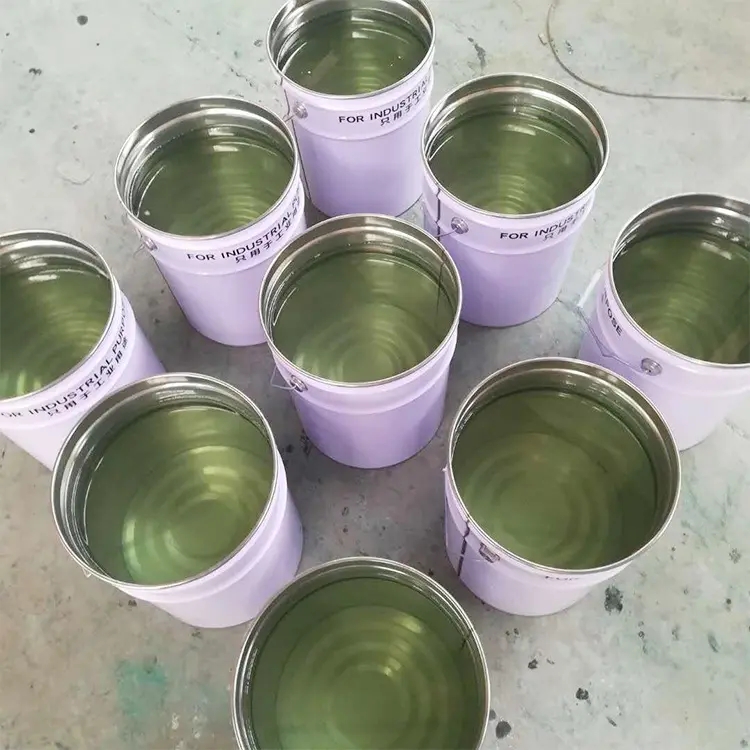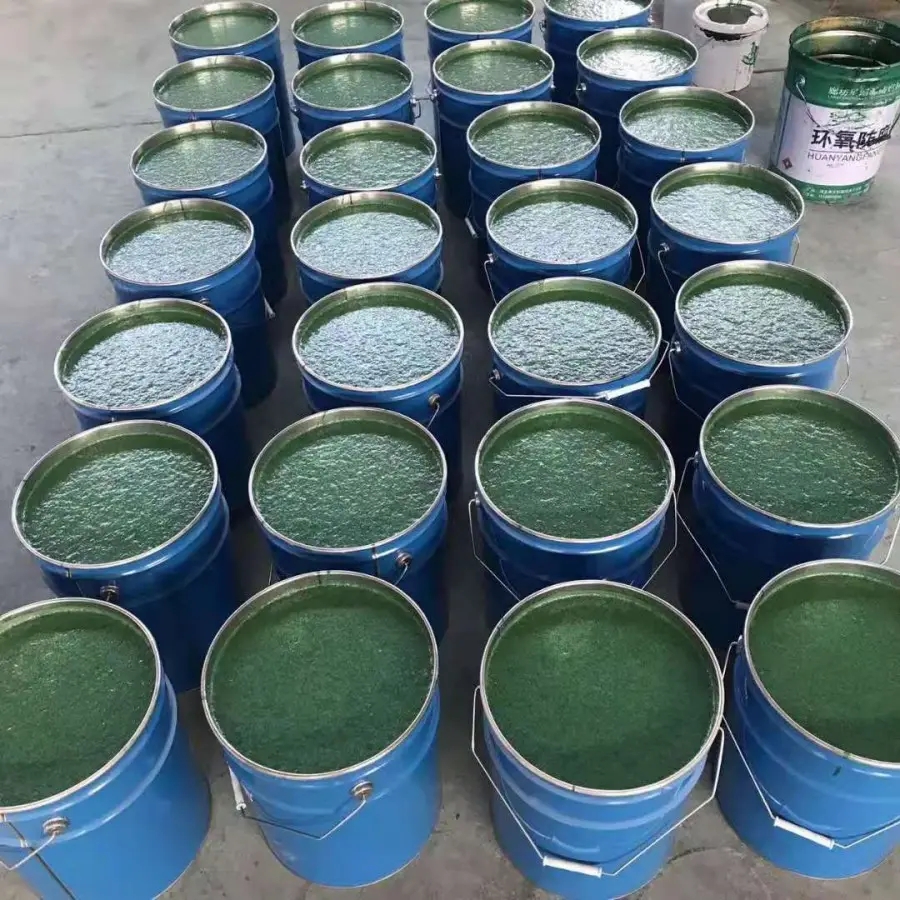Epoxy resin coating is one of the four pillars of synthetic resin coatings. There are many ways to classify it. In the paint industry, it is more commonly used to classify paints by use and paint state.
(1) Classification by purpose
According to use, it can be divided into architectural coatings, automotive coatings, ship coatings, wood coatings, machine coatings, sign coatings, anti-corrosion coatings, heat-resistant coatings, fire-retardant coatings, Temperature indicating paint, etc.
(2) Classification by coating status
According to state, it can be divided into solvent-based coatings, solvent-free coatings (liquid or solid), and water-based (water-emulsified and water-soluble) coatings.

Epoxy resin coating
(1) Amine-cured epoxy resin coating
Amine-cured epoxy resin coatings are cured at room temperature. Curing agents are mainly polyamines, amine adducts and polyamide resins. Curing is achieved due to cross-linking between the epoxy groups and the active hydrogen atoms of the curing agent.
①Polyamine cured epoxy resin coating
This type of epoxy resin coating is a two-component package that is prepared before construction and has a short service life. The paint film has good adhesion, flexibility and hardness. The fully cured paint film has good resistance to aliphatic hydrocarbon solvents, dilute acids, alkalis and salts. The molecular weight of epoxy resin should be around 900. When the molecular weight is above 1400, the epoxy value is low, there is less cross-linking, and the paint film after curing is too soft; when the molecular weight is below 500, the paint film is too brittle, the service life after paint preparation is too short, and it is inconvenient to use the curing agent. Use ethylenediamine, hexamethylenetriamine, diethylenetriamine, etc.
②Amine adduct cured epoxy resin coating
Due to the toxicity, irritation and odor of polyamines, as well as the possible performance degradation when their preparation amounts are inaccurate, modified polyamines are currently commonly used. The adduct is used as a curing agent. For example, the adduct obtained by the reaction of epoxy resin and excess ethylenediamine is used to replace the polyamine, which eliminates the odor and avoids the whitening of the paint film.
③Polyamide cured epoxy resin coating
Low molecular polyamide is formed by the condensation polymerization of unsaturated acid dimers or trimers of vegetable oils and polyamines. Because its molecule contains active amino groups, it can react with epoxy groups to cross-link into a network structure. Polyamide groups have long carbon chains and polar groups, and have good elasticity and adhesion. Therefore, in addition to functioning as a curing agent, it is also a good toughening agent and is also beneficial to improving weather resistance and construction performance.
The molecular weight of commonly used epoxy resins is around 900, and mixed solvents of ketones, aromatic hydrocarbons and alcohols are used, and they have good compatibility with epoxy resins. , also has good wettability to pigments.
The curing speed of polyamide as a curing agent is several times slower than that of amine curing, and the dosage ratio is not as strict as that of amine curing, so it is much more convenient to use.
Synthetic resin-cured epoxy resin coatings Many synthetic resins with reactive groups can themselves be used
The main film-forming substances of coatings. Such as phenolic resin, polyester resin, etc., when they are combined with epoxy resin, they are baked at high temperature (about 150~200℃ ), can be cross-linked to form an excellent coating film.

①Phenolic resin cured epoxy resin coating
Epoxy resin with a molecular weight of 2900~4000 is generally used. Because it contains more hydroxyl groups, it reacts quickly with the hydroxyl group of the phenolic resin; at the same time, the ring with a large molecular weight The oxygen resin molecular chain is long and the paint film has good elasticity. This type of resin paint is one of the best corrosion-resistant varieties among epoxy resin paints. It has excellent acid and alkali resistance, solvent resistance, and heat resistance. However, the paint film is dark in color and cannot be used as light-colored paint. Phenolic resin can be etherified with butanol to etherify diphenol-based propane formaldehyde resin. When used together with epoxy resin (molecular weight 2900), a coating with high mechanical strength and excellent chemical resistance can be obtained, with good storage stability.
②Amino resin cured epoxy resin coating
This kind of resin paint has light color, strong gloss, good flexibility and good chemical resistance. It is suitable for coating medical devices, instruments and equipment, and as a Canned paint, etc.
③Epoxy-amino-alkyd paint
This type of resin paint is made of non-drying, short-oil alkyd resin, epoxy resin, and amino resin that are miscible and cross-linked. Good adhesion, flexibility and chemical resistance, can be used as primer and anti-corrosion paint. The commonly used epoxy resin has a molecular weight of 900.
④Polyisocyanate-cured epoxy resin paint
The cross-linking reaction between the secondary hydroxyl groups of polymer (1400 and above) epoxy resin and polyisocyanate can be carried out at room temperature to form polyurethane . Therefore, it can be made into a normal temperature drying paint. The dried coating film has excellent water resistance, solvent resistance, chemical resistance and flexibility, and is used for coating underwater equipment or chemical equipment, etc.
Isocyanate-cured epoxy resin coatings are generally two-component: epoxy resin and solvent (pigment should be added to the paint) as one component, and polyisocyanate as the other. One component. The curing agent generally uses an adduct of polyisocyanate and polyol. If a blocked polyisocyanate is used as the curing agent, a storage-stable coating can be obtained. However, this kind of paint must be dried to cross-link and solidify the paint film. All solvents must not contain water. When preparing, NCO: —OH is about 0.7~1.1,
(3) Esterified epoxy resin coating
Also known as epoxy ester paint, it is the esterification reaction of vegetable oil fatty acids and epoxy resin hydrocarbons to generate epoxy ester. Using inorganic or organic bases as catalysts can accelerate the reaction.
Epoxy resin can be regarded as a polyol. One epoxy group is equivalent to two hydroxyl groups and can react with two molecular unit acids (i.e. one carboxyl group) Ester and water are produced. Commonly used acids include unsaturated acids (such as tung oil acid, linoleic acid, dehydrated ricinoleic acid, etc.), saturated acids (such as ricinoleic acid, etc.), and acid anhydrides (such as maleic anhydride, etc.). Epoxy ester paint varieties with different properties can be produced by using different proportions of different varieties. Epoxy ester paint is soluble in cheap hydrocarbon solvents, so its cost is low, and it can be made into varnish, enamel, primer and putty. Epoxy ester paint has a wide range of uses and is currently the one with the largest production volume and usage among cyclic resin paints.
Epoxy resins use varieties with larger molecular weights. Most of their molecular weights are around 1500, and some use 900-1000. After esterification, they are mostly used to make water-soluble electrophoretic paints. . The properties of the esterified coating are directly related to the properties, ratio, esterification process and type of epoxy resin of fatty acids. The esterified epoxy coating is the same as the alkyd resin coating, with strong adhesion and good toughness. The alkali resistance is slightly worse due to the presence of ester, and the corrosion resistance is not as good as the unesterified coating film. However, the cost is low and the anti-dusting performance is improved. This type of paint can be dried at room temperature or in the oven.

 微信扫一扫打赏
微信扫一扫打赏

